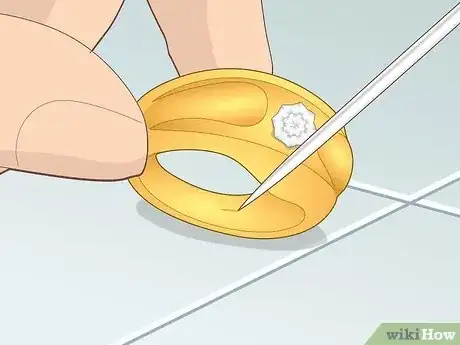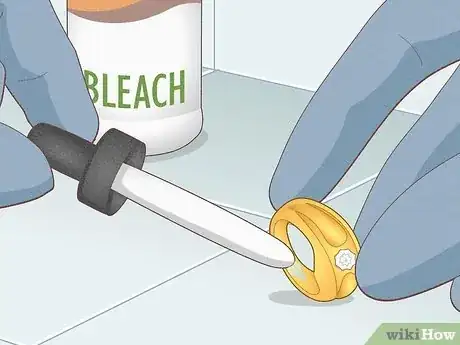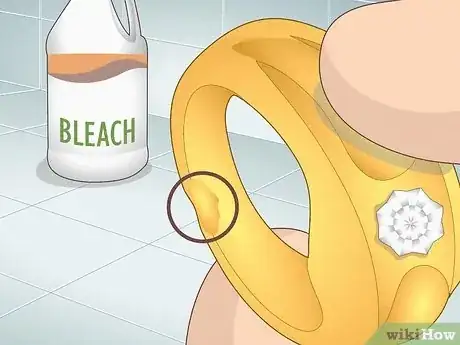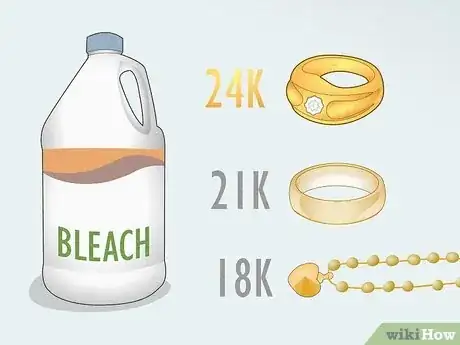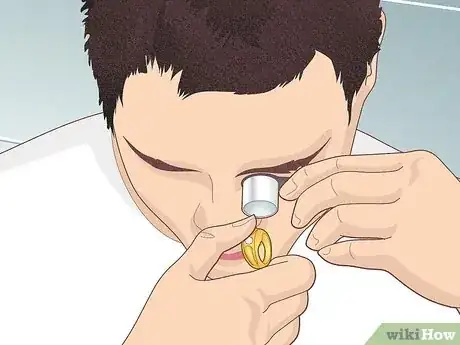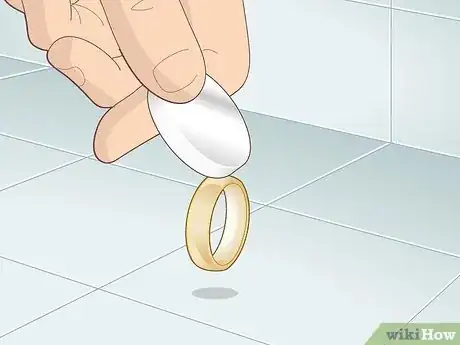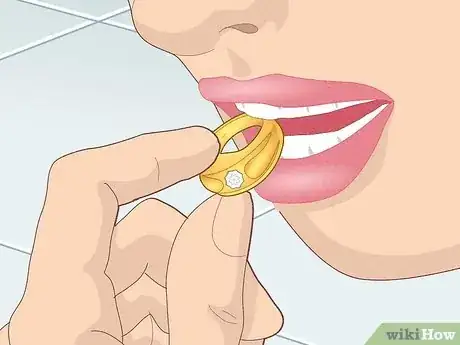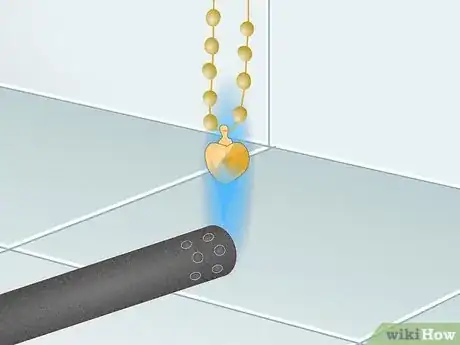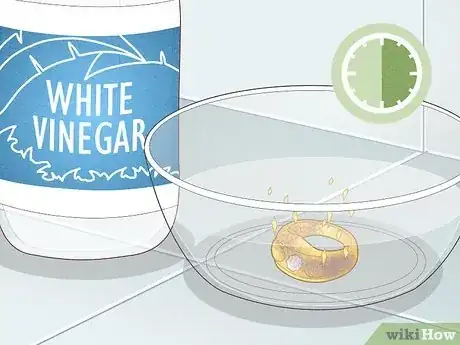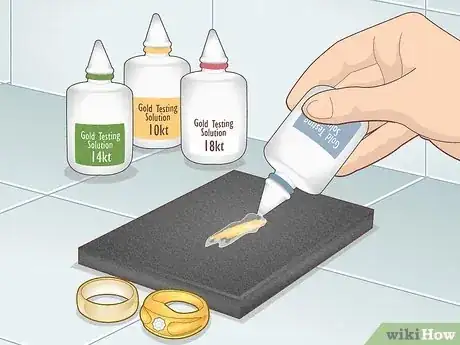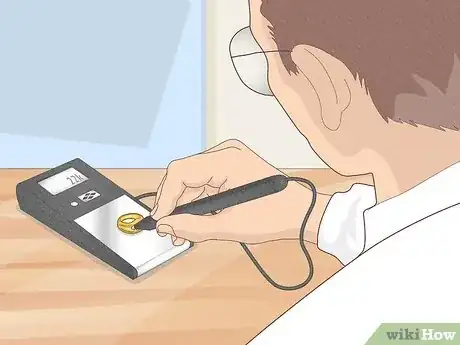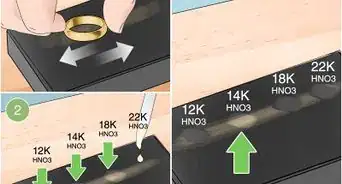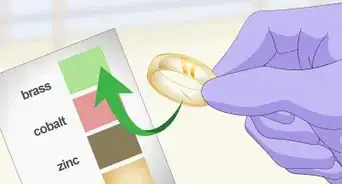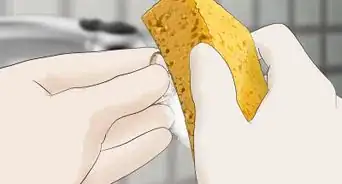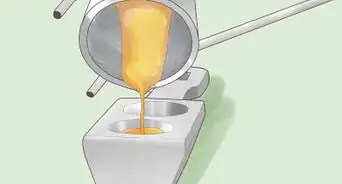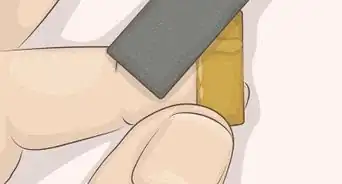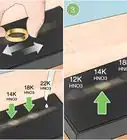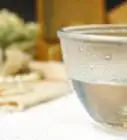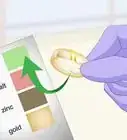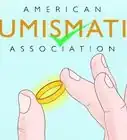This article was co-authored by Kennon Young and by wikiHow staff writer, Johnathan Fuentes. Kennon Young is a Gemological Institute of America (GIA) Graduate Gemologist, an American Society of Appraisers (ASA) Master Gemologist Appraiser, and a Jewelers of America (JA) Certified Bench Jeweler Technician. He received the highest credential in the jewelry appraisal industry, the ASA Master Gemologist Appraiser, in 2016.
There are 11 references cited in this article, which can be found at the bottom of the page.
This article has been viewed 2,810 times.
Wondering if grandma’s 24K gold earrings are real? Thinking of selling that wedding ring you found on the beach? If so, you might want to consider a simple bleach test. Unlike other metals, pure gold is very unreactive. It doesn’t tarnish or fade, and it won’t respond to everyday chemicals like bleach. But if gold is fake or mixed with other metals, a bleach test could reveal the truth. There are risks, though, since bleach can permanently damage certain types of gold. Thinking of trying it anyway? Read this guide carefully for some tips, warnings, and alternative options for testing your gold jewelry safely.
Things You Should Know
- Make a small scratch on the gold and add a drop of bleach. If it changes color, your jewelry is not 100% pure 24K gold.
- Bleach can permanently damage gold jewelry. It can’t tell you if your gold is fake, since most gold jewelry has other metals mixed in to give it strength.
- For alternative testing methods, try holding a magnet to your jewelry or dropping your gold in vinegar. Pure gold won’t stick to a magnet or react with vinegar.
Steps
Testing Gold with Bleach
-
1Make a small scratch on your gold jewelry with a razor or needle. Choose an inconspicuous spot, like the inside of a ring or the part of an earring that faces your earlobe. The scratch helps to remove dust, oils, oxidation, or other materials that could interfere with the test.
- Avoid areas that are close to gems. You don’t want to damage your diamond with bleach!
-
2Use an eyedropper to apply a drop of bleach to the scratch. Watch closely and let the bleach sit for 1 minute. Be careful not to apply too much bleach since it could discolor large sections of your jewelry.
- Wear rubber gloves when handling bleach. Try not to breathe in the fumes, and be careful not to get it in your eyes on your bare skin.[1]
Advertisement -
3After 1 minute, check to see if the spot changed color. If nothing happens, it means that your jewelry is probably 100% pure 24K gold. However, if the spot appears darkened, faded, or otherwise changed, it means that your jewelry contains other metals.
- It’s possible that your jewelry contains real gold, even if it changes color. For example, 10K yellow gold contains over 41% real gold, with silver and copper mixed in. The silver and copper could react with the bleach, discoloring the metal.
Disadvantages of Using Bleach
-
1Bleach can damage your gold jewelry. The bleach might react with other metals mixed into your gold jewelry, permanently damaging it.[2] For this reason, some experts advise against using bleach on your gold, whether it’s for testing, cleaning, or any other purpose.
- Most gold jewelry has other metals mixed into it, since pure 24K gold is too soft for jewelry.[3]
-
2Bleach can’t tell you if your gold is fake. Instead, it can only tell you if it’s 100% pure 24K gold, since pure gold doesn’t react with bleach. But in many cases, other metals are mixed into gold to give it strength or change its color—like with rose or white gold—and even yellow gold isn’t always pure.[4]
- If your gold is real but has any other metals mixed in, the bleach could still discolor or damage it, just as it would if the gold was fake.
-
3Only a professional can prove that your jewelry contains real gold. A professional could be a jewelry buyer (like a pawn shop) or an expert jewelry appraiser. While either person may charge money to examine your jewelry, an appraiser could be more trustworthy since you’ll be paying them for their neutral opinion.
Other Methods for Testing Pure 24K Gold
-
1Try the magnet test. Hold a strong magnet to your jewelry to see if it sticks. If your jewelry is 100% 24K gold, it won’t be attracted to the magnet at all. But if it does stick to the magnet, it definitely contains other metals besides gold.[5]
- Use a neodymium magnet if you have one. These are incredibly strong and will attract any metal that’s even slightly magnetic. Just keep them away from credit cards, smartphones, and other electronic devices, since the magnetic field can damage these items.[6]
- Hematite, a grayish-black stone that’s highly magnetic, is sometimes used in jewelry alongside gold. Your gold jewelry may stick to a magnet if it’s made with hematite stones.[7]
-
2Gently bite your gold jewelry. Gold is an extremely soft metal, so if your bite leaves teeth marks, there’s a good chance it’s pure 24K gold. Be careful not to bite too hard. You don’t want to damage the gold or break a tooth.[8]
- Other metals are soft too, so this test can’t prove conclusively that your gold is pure.
- Remember, your jewelry can still contain real gold even if it’s not 100% pure 24K gold.
-
3Carefully hold your gold up to a flame. Pure gold doesn’t burn or darken when exposed to heat and only melts at extremely high temperatures. But pyrite—a.k.a. “fool’s gold”—will burn, as will certain steel alloys. If your gold catches fire or darkens, it’s not pure.[9]
- Use caution when working with an open flame. Metals heat up very quickly, so you could easily burn yourself if your gold gets too hot.
- Pure gold may appear slightly brighter when heated, but the color returns to normal after it cools.
-
4Leave your gold jewelry in a cup of white vinegar for 30 minutes. Then wash it off with clean water. If your gold is pure, the vinegar will simply remove any dirt or grime that’s built up, leaving the gold shiny and clean. But if your jewelry changes color or breaks apart, it’s not pure gold.[10]
- Brass, which sometimes looks like gold, will not be affected by vinegar. Try additional tests, such as an at-home acid test kit, to determine if your jewelry is brass or gold.
Safer Ways to Test Your Gold
-
1Use an acid-based home test kit. Purchase a test online, or ask a local jeweler where you can obtain one. In general, these tests work by applying a small amount of acid to a piece of gold. The results are used to determine the purity of gold—that is, whether it’s 24K, 18K, 10K, and so on. The purer the gold, the more resistant it is to acid, while less pure gold will corrode or react more easily when acid is applied.[11]
- Each home test will come with its own instructions. Make sure to read and follow the instructions carefully when testing your gold.
- This method is also called the “touchstone” method. It’s used by real industry professionals—including the Gemological Institute of America, an agency that certifies the value of gems and precious metals used in jewelry.
-
2Have a professional appraiser examine your jewelry. The appraiser will charge you a fee to inspect your jewelry using scientific methods that are less likely to damage the gold. They’ll also be able to tell you its exact karat, approximate value (that is, the amount of money you could make from selling it), and which specific metals were mixed into the gold, if any.
- A jewelry appraiser is generally more trustworthy than a jewelry buyer, like a pawn shop or jewelry store. An appraiser is not buying your jewelry and is only paid for their analysis, whereas a buyer has an incentive to underestimate your jewelry’s value so that they can resell it to someone else at a higher price.
Warnings
- Bleach can ruin gold jewelry.⧼thumbs_response⧽
- Most professionals do not recommend testing your gold jewelry with bleach.⧼thumbs_response⧽
- Consider alternative options, like home gold test kits.⧼thumbs_response⧽
- Only a professional can tell you whether your gold is fake. A jewelry appraiser can safely test the purity of your gold jewelry.⧼thumbs_response⧽
References
- ↑ https://www.cdc.gov/disasters/bleach.html
- ↑ https://www.gia.edu/gia-news-research-secrets-keep-diamond-sparkling
- ↑ http://www.csun.edu/science/ref/equipment/acquisition/common.htm
- ↑ https://www.gold.org/about-gold/about-gold-jewellery
- ↑ https://homeygears.com/how-to-test-gold-at-home-with-bleach/
- ↑ https://stemazing.org/wp-content/uploads/2018/11/TEP-Eddy-Current-Tube.pdf
- ↑ https://sciphile.oit.umass.edu/lessons/magnetic-materials
- ↑ https://www.jewelrynotes.com/how-to-test-if-gold-is-pure-24k/
- ↑ https://eartheclipse.com/science/minerals/is-gold-flammable.html
